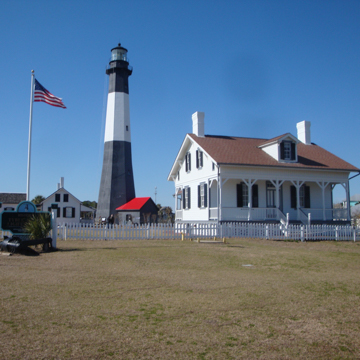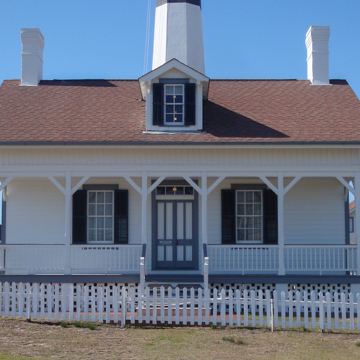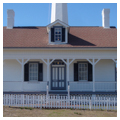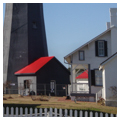“From Rabun Gap to Tybee Light” is a phrase popular among Georgia orators. It describes the considerable length of the state, the country’s largest east of the Mississippi. Rabun Gap is a natural land formation whileTybee Light is an historic man-made landmark. One of the earliest structures in Georgia, it was built by the colony’s founder, James Oglethorpe, to mark the entrance to the Savannah River and to warn ships of the shallow coastal waters at Tybee Island. The current edifice is the fourth in a series of “daymarks” and lighthouses erected here.
Oglethorpe’s first landmark was built of wood in 1733, just three years after the colony was founded. It towered to a height of 90 feet and was the tallest structure of its kind in America at the time. Standing too close to the shore, it was constantly threatened by beach erosion and was finally washed away in a storm in 1741. By then, a second tower had already been started but it was also too close to the water. In 1773, work began on a third tower, this time in brick and set back far enough to avoid beach erosion. That tower rose to a height of 100 feet and had wood stairs and landings inside. Today it serves as the base of the current tower. The lighthouse required a keeper on site to tend to the beacon, which was at first lit by large candles, then by sixteen lamps burning whale oil at first, then hot lard, and finally, kerosene. In 1857 a second order Fresnel Lens (measuring eight feet tall) was installed, a French invention of 1827 that employed molded glass prisms in a brass frame to magnify the light source.
In 1861 Confederate troops at nearby Fort Pulaski burned the interior stairs of the tower to prevent use of the lighthouse by federal troops. When Union soldiers, intending to attack Fort Pulaski, arrived on Tybee Island they quickly repaired the stairs. A dynamite explosion late in 1862 destroyed the upper section of the Tybee Lighthouse. Between 1866 and 1867 a new tower was built in brick, adding eighty-five feet to the sixty-foot base of the 1773 tower, and replacing the wooden stairs with a cast-iron staircase. A new first order Fresnel lens (measuring nine feet tall) was installed in 1867, its light visible to ships eighteen miles off the coast.
The station required a series of support buildings over the years. The extant 1812 summer kitchen is one of the earliest surviving structures in Georgia and became a storage building when kitchens were later attached to keepers’ quarters in 1910. During the Civil War, a small barracks building was built for Confederate troops and was later adapted as the second assistant keeper’s house in 1867. A small building was erected at the base of the lighthouse that same year to store and heat lard (and later oil) for the light. For use in the lamps during the years before kerosene, keepers had to haul buckets of warm lard to the top and keep it from congealing. In 1881 the Head Keeper’s House was built in the prevailing Stick Style, a frame construction that employed stick-like brackets, posts, and other trim, including horizontal and vertical wall weave surfaces to express the wood-frame character of the structure. The first assistant keeper’s house dates to 1885, the year an earlier residence on the same site burned. This was also the year a major hurricane crossed Tybee Island, and throughout much of the later nineteenth century, cracks in the masonry and other needed repairs prompted repeated calls for a new lighthouse. In 1886, the tower survived a large Charleston earthquake, convincing Congress that a new lighthouse was not yet necessary. A brick fuel storage with concrete floor and tin roof was erected in 1890 as a more appropriate building to house kerosene. Before the end of the century, a picket fence was installed around the station buildings in 1894, and construction on Fort Screven began in 1897 with the building of the Battery Brumby, a sign that the Spanish American War was likely imminent.
After the stock market crash of 1929, economizing measures prompted the 1933 transition to electricity to light the Tybee Island lighthouse lamp. Oddly enough, even as pressure was mounting to eliminate the need for on-site lighthouse keepers, a three-car garage was also built during the 1930s. In 1939 the United States Coast Guard took over operation of the lighthouse and maintained it until 1987, when the Guard vacated Tybee for new quarters on Cockspur Island. The Tybee Island Historical Society then developed the site as a museum and continues to operate Tybee Island Lighthouse.
Throughout the last century and a half, the daymarking of the lighthouse has changed with repeated repainting. In 1867 the entire lighthouse was white; between 1887 and 1965 the base of the tower up to about sixty feet was black, the top was also black, and the middle was painted white. Dimensions of this black-white-black design varied: from 1887 to 1914 the white extended above the sixty-foot black base to the gallery walk; from 1914 to about 1916–1917 this middle white section stopped about ten feet below the gallery walk; and between 1917 and 1965 it rose from the same sixty-foot black base to about twenty feet below the gallery walk, which is its current configuration since the restoration of 1998–1999. For about five years after 1965, the lower fifty feet was painted white and the remainder of the tower (to the gallery walk) was a dull gray; then in 1970, lasting twenty-eight years until the recent renovations, the full tower above the fifty-foot level was black, and below remained white. The 1916–1965 design was reinstated in 1998 as the design of longest duration.
In 2002, in the midst of renovations of the houses, ownership of the Tybee Island Light Station was transferred to the Tybee Island Historical Society under the National Historic Lighthouse Preservation Act. The historical society restored the Head Keeper’s house (2000–2001), the First Assistant Keeper’s house (2003–2004), and in 2005 the Second Assistant Keeper’s house was converted to a lecture hall, art gallery, and audio-visual space.
References
Godley, Margaret. Historic Tybee Island. Savannah: Savannah Beach Chamber of Commerce, 1988 (first published 1958).
Chambers, Cullen G. A Brief History of the Tybee Island Light Station.Tybee Island: Tybee Island Historical Society, 1999.
Kagerer, Rudy. A Guidebook to Lighthouses in North Carolina, South Carolina, Georgia, and Florida’s East Coast: Their History, Legends, Tales, and Whereabouts. Athens, GA: Lighthouse Enterprises, Inc., 1998 (revision of 1996 edition).















